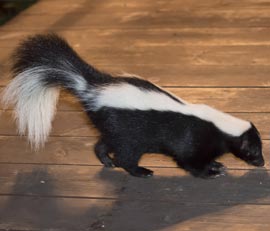Skunk Pest Control
Why Do I Have Skunks?
Skunk Removal & Exclusion
Immediate Skunk Control
What To Do If Sprayed By A Skunk
Quick Facts About Skunks
Habits
The white striped skunk feeds on snails, insect’s, berries, mice and rats. Typically skunks dig up lawns and flowerbeds to find grubs and insects. They are an animal that looks for a convenient house which range from tree stumps, piles of rocks to abandoned building. The female may den with several other females but males are always solitary. The white striped skunk likes to live close to a water source. They are nocturnal and are usually the ones found along the roadside with that strong detectable odor. The odor under the right conditions can travel up to a mile. Skunks burrow near sources of food and water. They feed on grubs, insects and pet food. A newborn skunk can spray as early as eight days old, but they don’t learn to aim until after they open their eyes, around the one month mark. Skunks have great hearing ability, but they’re vision is poor. Skunks can only see up to 10-12 feet away, which makes them susceptible to cars.
Habitat
Skunks prefer to burrow in secure areas like under decks and houses, in sheds or crawl spaces. They usually seek out existing holes at soil level to be close to their source of food. Be sure to close off any area the skunk can use as a den, do not leave pet food outside and make sure your side yard gates no more than an inch off the ground. Skunks eat grubs and insects that thrive in moist conditions. Reducing the amount of moisture on your property will tend to limit your exposure to skunks.
Threats
If a skunk feels threatened, it will try to flee first. If it is cornered or trapped it will spray an odorous, greasy liquid on the “predator”. If you encounter a skunk always run horizontal or 90 degrees away from the rear of the Skunk. The defensive mechanism for a skunk is to release a sticky mucus from under its tail that can travel as much as 50 feet. Once sprayed by a skunk, pets may retain the odor for up to one month. It is important to note, DO NOT put contaminated clothing into the washing machine. It may ruin the equipment permanently. If pets or children are sprayed by a skunk, don’t panic. Combine 1/4 cup of baking soda, 2 teaspoons of a dish soap and 2 pints of hydrogen peroxide. If you have a very large pet, simply double the amounts of these three ingredients. Wash your pet outside, shampooing your pets hair thoroughly with the mixture. The mixture will fizz as baking soda and peroxide are combined. If possible, avoid getting any of this mixture in your pet's eyes or on its nose. Please note, you may need to reapply this mixture multiple times depending on the severity of the skunk odor.
Prevention
Our wildlife specialist will help design a plan specific to your property to prevent skunks.
Skunk Removal Testimonials
100% Satisfaction Guaranteed
Cities We Service
Don't see your location? Most surrounding areas covered. Call for more information.
Los Angeles County
Orange County
Locations
Santa Ana1415 East McFadden Ave. Suite D Santa Ana CA 92705
San Diego934 S Andreasen Dr. Unit DEscondido CA 92029
All Rights Reserved | Griffin Pest Management


